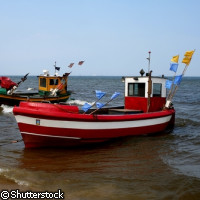Overfishing driving evolution of Baltic cod
Overfishing is driving the evolution of the cod populations in the Baltic Sea and pushing them towards extinction, according to new research by Swedish and American scientists. The researchers found that cod caught today are on average smaller and younger than those caught by our Stone Age ancestors 4,500 years ago. 'Some fisheries, including that for cod, are now known to cause "juvenescence", or the evolution of younger, smaller adult fish,' explained Dr Karin Limburg of the State University of New York (SUNY) College of Environmental Science and Forestry. 'The ecological and economic consequences both appear to be negative.' Dr Limburg and her team hope that their findings, which are published in the Proceedings of the Royal Society B: Biological Science, will help fisheries managers assess the state of their stocks more accurately. A major problem in fisheries management is a lack of baseline data against which today's fish stocks can be compared. 'With cod populations at historic lows and challenges to rebuild them mounting, it is important to explore the past for clues about characteristics such as stock sizes, exploitation rates, age and size structure, etc. and what ecological roles cod would have played when their populations were larger,' the researchers write. In this study, the researchers analysed fish remains from a 4,500-year-old settlement on the Swedish island of Gotland, which lies in the middle of the Baltic Sea. By measuring vertebrae, the scientists were able to calculate the length of the fish caught. Meanwhile analyses of structures called 'otoliths' enabled the researchers to work out the ages of the fish caught. These calcium carbonate structures, which are also known as 'earstones', are found in the fishes' heads, where they form a key part of its hearing and balance system. The earstones grow with the fish, and the layers can then be counted like tree rings to estimate the age of the fish when it died. Finally, the scientists examined fish hooks found at the Gotland site and estimated the size of fish they were designed to catch. These analyses revealed that on average, the cod caught in the Stone Age were around 56 cm long; in comparison today's catch averages 49 cm. The Stone Age fish were also older when caught, with an average age of 4.7 years. Today's fish are over a year younger when caught. Furthermore, the Neolithic fishermen rarely caught fish far out to sea, where the biggest and oldest fish tend to live. In contrast modern trawlers are able to fish in the deepest parts of the Baltic and take the biggest fish. Removing these large fish from the ecosystem has a massive impact on the population. The biggest fish produce both the most eggs and the highest quality eggs, i.e. those which are most likely to survive. They also have the most knowledge on the locations of the best spawning grounds. Without these matriarchs, the population is less likely to spawn productively. 'It's such an overfished system,' said Dr Limburg of the Baltic Sea cod. 'The big concern is that overexploitation is causing the fish to evolve. The finding that humans can actually cause evolution of fish populations, which in turn can drive their degradation, is relatively new and is drawing a lot of attention.' Last year ICES (the International Council for the Exploration of the Sea) recommended that the cod fishery in the eastern Baltic be closed entirely and called for a 50% cut in fishing quotas in the western fishery.
Countries
Sweden, United States



